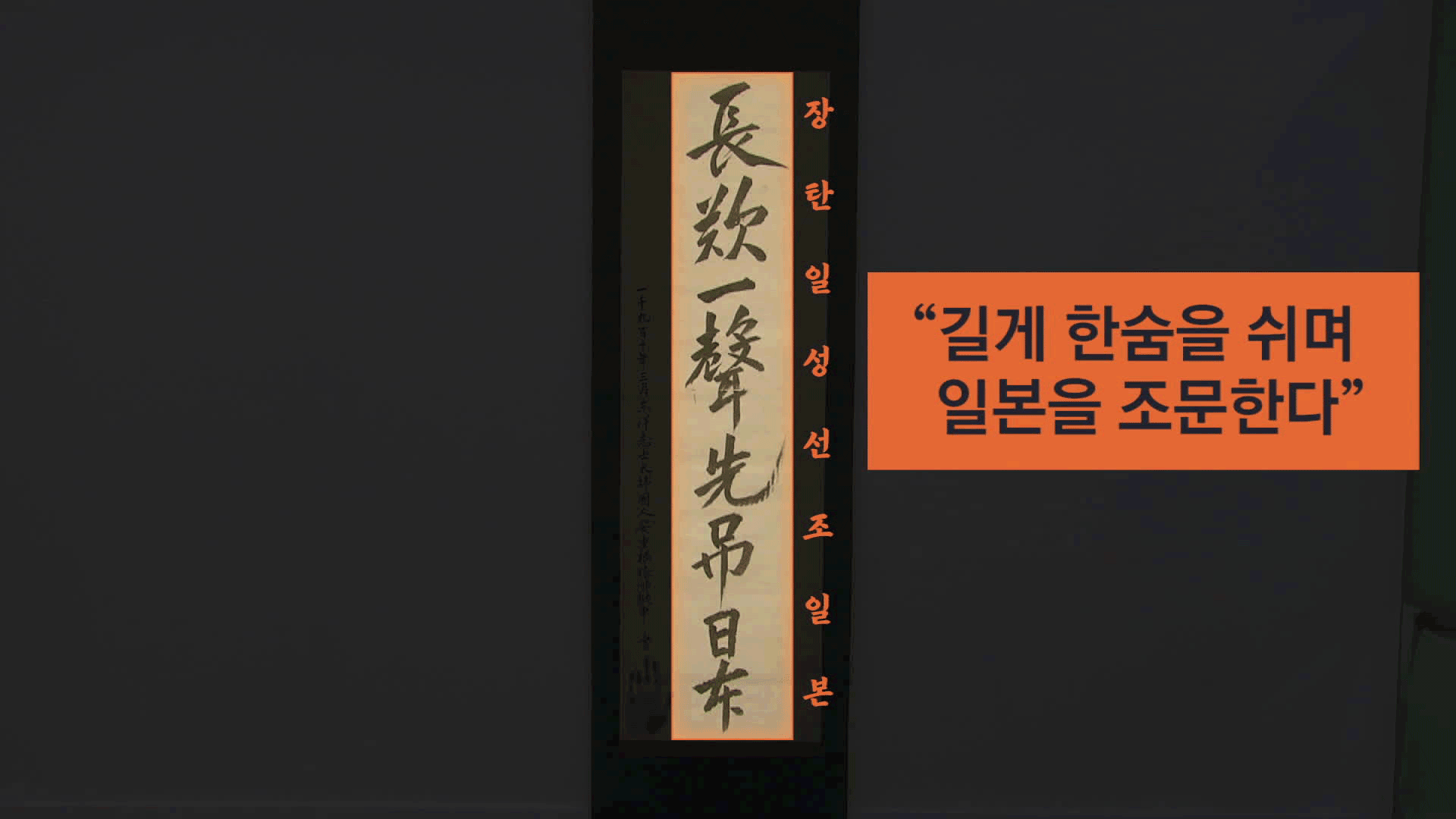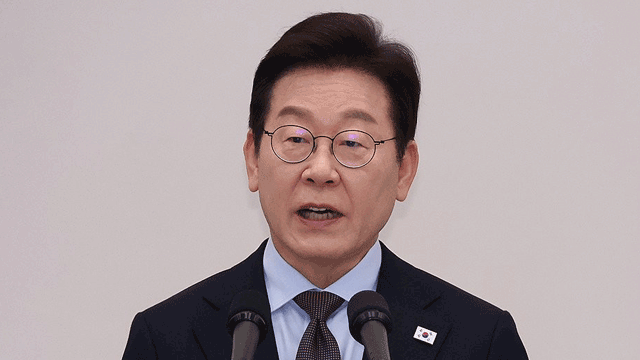[Anchor]
A piece of calligraphy by patriot Ahn Jung-geun has returned to Korea after 115 years and was revealed for the first time on KBS.
It contains a direct mention of the downfall of Japan.
It has been evaluated as fully embodying the spirit of Ahn more than any previous calligraphy.
Reporter Lee Se-jung has the story.
[Report]
As I carefully unroll the tightly bound scroll, the characters begin to appear.
Eight clear characters written on silk, measuring 41 cm wide and 135 cm long.
"장탄일성 선조일본," which means "I sigh deeply and mourn for Japan."
This directly mentions the downfall of Japan.
In March 1910, while imprisoned in the Lüshun prison, Ahn Jung-geun wrote this calligraphy before his execution.
Each character embodies Ahn's spirit.
[Lee Wan-woo/Honorary Professor, Graduate School of Korean Studies, Academy of Korean Studies: "The last stroke of the character '장' (jang) is said to be a 'paim.' The intense final stroke seems to express his inner feelings well."]
It has been well preserved without any damage, and notably, the handprint showing the missing top joint of his ring finger, which is a symbol of Ahn, is clearer than in any of his other calligraphies.
[Lee Wan-woo/Honorary Professor, Academy of Korean Studies: "(Other calligraphy) can be smudged or appear dark due to the ink, but the quality of the handprint is very good, making it a standard for fingerprint analysis."]
This is also the first time a calligraphy where Ahn referred to himself as an 'Eastern patriot' has been discovered.
It is said to contain a concentrated critique of Japanese imperialism, which disrupts peace.
[Kim Young-ho/Chairman, Northeast Asia Peace Foundation: "'Mourning for the path (of imperialism)' is the conclusive statement of the Eastern peace theory and is the strongest warning directed at Japan, isn't it?"]
This calligraphy was kept at the Tokyo home of a descendant of a high-ranking official from the Japanese Governor-General of Taiwan at the time.
This year, marking the 80th anniversary of liberation, it was permanently returned to Korea after persuasion from a historical document excavator and the Gyeonggi-do branch of the Heritage of Korean Independence.
KBS News, Lee Se-jung.
A piece of calligraphy by patriot Ahn Jung-geun has returned to Korea after 115 years and was revealed for the first time on KBS.
It contains a direct mention of the downfall of Japan.
It has been evaluated as fully embodying the spirit of Ahn more than any previous calligraphy.
Reporter Lee Se-jung has the story.
[Report]
As I carefully unroll the tightly bound scroll, the characters begin to appear.
Eight clear characters written on silk, measuring 41 cm wide and 135 cm long.
"장탄일성 선조일본," which means "I sigh deeply and mourn for Japan."
This directly mentions the downfall of Japan.
In March 1910, while imprisoned in the Lüshun prison, Ahn Jung-geun wrote this calligraphy before his execution.
Each character embodies Ahn's spirit.
[Lee Wan-woo/Honorary Professor, Graduate School of Korean Studies, Academy of Korean Studies: "The last stroke of the character '장' (jang) is said to be a 'paim.' The intense final stroke seems to express his inner feelings well."]
It has been well preserved without any damage, and notably, the handprint showing the missing top joint of his ring finger, which is a symbol of Ahn, is clearer than in any of his other calligraphies.
[Lee Wan-woo/Honorary Professor, Academy of Korean Studies: "(Other calligraphy) can be smudged or appear dark due to the ink, but the quality of the handprint is very good, making it a standard for fingerprint analysis."]
This is also the first time a calligraphy where Ahn referred to himself as an 'Eastern patriot' has been discovered.
It is said to contain a concentrated critique of Japanese imperialism, which disrupts peace.
[Kim Young-ho/Chairman, Northeast Asia Peace Foundation: "'Mourning for the path (of imperialism)' is the conclusive statement of the Eastern peace theory and is the strongest warning directed at Japan, isn't it?"]
This calligraphy was kept at the Tokyo home of a descendant of a high-ranking official from the Japanese Governor-General of Taiwan at the time.
This year, marking the 80th anniversary of liberation, it was permanently returned to Korea after persuasion from a historical document excavator and the Gyeonggi-do branch of the Heritage of Korean Independence.
KBS News, Lee Se-jung.
■ 제보하기
▷ 카카오톡 : 'KBS제보' 검색, 채널 추가
▷ 전화 : 02-781-1234, 4444
▷ 이메일 : kbs1234@kbs.co.kr
▷ 유튜브, 네이버, 카카오에서도 KBS뉴스를 구독해주세요!
- Ahn Jung-geun calligraphy returns
-
- 입력 2025-08-15 01:56:13

[Anchor]
A piece of calligraphy by patriot Ahn Jung-geun has returned to Korea after 115 years and was revealed for the first time on KBS.
It contains a direct mention of the downfall of Japan.
It has been evaluated as fully embodying the spirit of Ahn more than any previous calligraphy.
Reporter Lee Se-jung has the story.
[Report]
As I carefully unroll the tightly bound scroll, the characters begin to appear.
Eight clear characters written on silk, measuring 41 cm wide and 135 cm long.
"장탄일성 선조일본," which means "I sigh deeply and mourn for Japan."
This directly mentions the downfall of Japan.
In March 1910, while imprisoned in the Lüshun prison, Ahn Jung-geun wrote this calligraphy before his execution.
Each character embodies Ahn's spirit.
[Lee Wan-woo/Honorary Professor, Graduate School of Korean Studies, Academy of Korean Studies: "The last stroke of the character '장' (jang) is said to be a 'paim.' The intense final stroke seems to express his inner feelings well."]
It has been well preserved without any damage, and notably, the handprint showing the missing top joint of his ring finger, which is a symbol of Ahn, is clearer than in any of his other calligraphies.
[Lee Wan-woo/Honorary Professor, Academy of Korean Studies: "(Other calligraphy) can be smudged or appear dark due to the ink, but the quality of the handprint is very good, making it a standard for fingerprint analysis."]
This is also the first time a calligraphy where Ahn referred to himself as an 'Eastern patriot' has been discovered.
It is said to contain a concentrated critique of Japanese imperialism, which disrupts peace.
[Kim Young-ho/Chairman, Northeast Asia Peace Foundation: "'Mourning for the path (of imperialism)' is the conclusive statement of the Eastern peace theory and is the strongest warning directed at Japan, isn't it?"]
This calligraphy was kept at the Tokyo home of a descendant of a high-ranking official from the Japanese Governor-General of Taiwan at the time.
This year, marking the 80th anniversary of liberation, it was permanently returned to Korea after persuasion from a historical document excavator and the Gyeonggi-do branch of the Heritage of Korean Independence.
KBS News, Lee Se-jung.
A piece of calligraphy by patriot Ahn Jung-geun has returned to Korea after 115 years and was revealed for the first time on KBS.
It contains a direct mention of the downfall of Japan.
It has been evaluated as fully embodying the spirit of Ahn more than any previous calligraphy.
Reporter Lee Se-jung has the story.
[Report]
As I carefully unroll the tightly bound scroll, the characters begin to appear.
Eight clear characters written on silk, measuring 41 cm wide and 135 cm long.
"장탄일성 선조일본," which means "I sigh deeply and mourn for Japan."
This directly mentions the downfall of Japan.
In March 1910, while imprisoned in the Lüshun prison, Ahn Jung-geun wrote this calligraphy before his execution.
Each character embodies Ahn's spirit.
[Lee Wan-woo/Honorary Professor, Graduate School of Korean Studies, Academy of Korean Studies: "The last stroke of the character '장' (jang) is said to be a 'paim.' The intense final stroke seems to express his inner feelings well."]
It has been well preserved without any damage, and notably, the handprint showing the missing top joint of his ring finger, which is a symbol of Ahn, is clearer than in any of his other calligraphies.
[Lee Wan-woo/Honorary Professor, Academy of Korean Studies: "(Other calligraphy) can be smudged or appear dark due to the ink, but the quality of the handprint is very good, making it a standard for fingerprint analysis."]
This is also the first time a calligraphy where Ahn referred to himself as an 'Eastern patriot' has been discovered.
It is said to contain a concentrated critique of Japanese imperialism, which disrupts peace.
[Kim Young-ho/Chairman, Northeast Asia Peace Foundation: "'Mourning for the path (of imperialism)' is the conclusive statement of the Eastern peace theory and is the strongest warning directed at Japan, isn't it?"]
This calligraphy was kept at the Tokyo home of a descendant of a high-ranking official from the Japanese Governor-General of Taiwan at the time.
This year, marking the 80th anniversary of liberation, it was permanently returned to Korea after persuasion from a historical document excavator and the Gyeonggi-do branch of the Heritage of Korean Independence.
KBS News, Lee Se-jung.
-
-

이세중 기자 center@kbs.co.kr
이세중 기자의 기사 모음
-
이 기사가 좋으셨다면
-
좋아요
0
-
응원해요
0
-
후속 원해요
0















이 기사에 대한 의견을 남겨주세요.